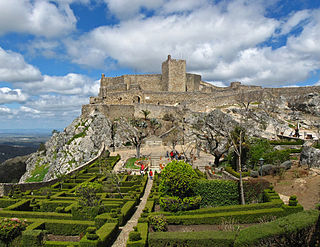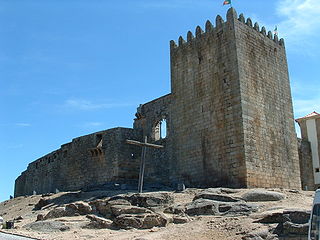
The Castle of Almourol is a medieval castle atop the islet of Almourol in the middle of the Tagus River, located in the civil parish of Praia do Ribatejo, 4 kilometres (2.5 mi) from the municipal seat of Vila Nova da Barquinha, in Portugal's Oeste e Vale do Tejo region. The castle was part of the defensive line controlled by the Knights Templar, and a stronghold used during the Portuguese Reconquista.

São Jorge Castle, sometimes known in English as Saint George's Castle, is a historic castle in the Portuguese capital of Lisbon, located in the freguesia of Santa Maria Maior. Human occupation of the castle hill dates to at least the 8th century BC while the oldest fortifications on the site date from the 2nd century BC. The hill on which Saint George's Castle stands has played an important part in the history of Lisbon, having served as the location of fortifications occupied successively by Phoenicians, Carthaginians, Romans, and Moors, before its conquest by the Portuguese in the 1147 Siege of Lisbon. Since the 12th century, the castle has variously served as a royal palace, a military barracks, home of the Torre do Tombo National Archive, and now as a national monument and museum.

The Castle of Castelo Rodrigo is a medieval castle in the civil parish of Castelo Rodrigo in the municipality of Figueira de Castelo Rodrigo, district of Guarda in Portugal.

The Castle of Alcoutim is a medieval castle in the civil parish of Alcoutim, in the municipality of the same name, in the southeastern Algarve of Portugal. Built in the 13th century, the castle stands in a dominant position on a hill south of the parish seat of Alcoutim on the right bank of the San Marcos River, opposite the territory of Sanlúcar de Guadiana.

The Castle of Beja is a medieval castle in the civil parish of Beja, municipality of Beja, Portuguese district of Beja.

The Castle of Lousã, also known as the Castle of Arouce, is a classified National Monument situated 2 kilometres (1.2 mi) from the civil parish of Lousã e Vilarinho, municipality of Lousã. It was constructed in the second-half of the 11th century, on the right margin of the River Arouce.

The Castle of Monsanto is a medieval castle located in the civil parish of Monsanto e Idanha-a-Velha, in the municipality of Idanha-a-Nova, Portuguese district of Castelo Branco.

The Castle of Redondo is a medieval castle located in the civil parish of Redondo, in the municipality of Redondo, Portuguese Évora.

The Castle of Vilar Maior is a well-preserved medieval castle located in the civil parish of Aldeia da Ribeira, Vilar Maior e Badamalos, in the municipality of Sabugal, Guarda district, Portugal.

The Castle of Marvão is a well-preserved medieval castle located in the civil parish of Santa Maria de Marvão, in the municipality of Marvão, Portuguese district of Portalegre.

The Castle of Vinhais is a medieval castle located in the civil parish of Vinhais, municipality of Vinhais, Portuguese district of Bragança.
The Castle Hill of Miranda, also known as the Fortress Hill, is a medieval castle located in the village of Outeiro in the district of Bragança, Portugal.

The Castle of Serpa is a medieval castle located in the civil parish of Serpa, in the municipality of Serpa, Portuguese district of Beja.
The Castle of Sernancelhe is a medieval castle in the civil parish of Sernancelhe e Sarzeda, municipality of Sernancelhe, in the Portuguese district of Viseu.

The Castle of Tavira is a medieval castle located in the parish of Santiago, Tavira municipality, Faro district of Portugal. In a dominant position over the mouth of the river Gilão, the settlement has developed as an important sea port since antiquity, with its predecessors dating back to the 8th century BC, passing through the hands of Phoenicians, Greeks, Celts, Carthaginians, Romans, Moors and the Portuguese crown.

The Castle of Castelo Bom is a medieval castle in the civil parish of Castelo Bom, municipality of the Almeida in the district of Guarda in the Centre region of Portugal.

The Castle of Belmonte is a medieval castle located in the municipality of Belmonte, Castelo Branco district in Portugal.

The Castle of Borba is a medieval castle located in the civil parish of Borba, municipality of Borba, Portuguese district of Evora.

The Castle of Monforte, also referred to as Castelo de Monforte de Rio Livre, is a medieval castle located in the Águas Frias parish, Monforte de village, Chaves municipality in Vila Real district of Portugal.

The Fort São Sebastião of Castro Marim is located in the village, parish and municipality of Castro Marim, in the District of Faro, in Portugal.


















